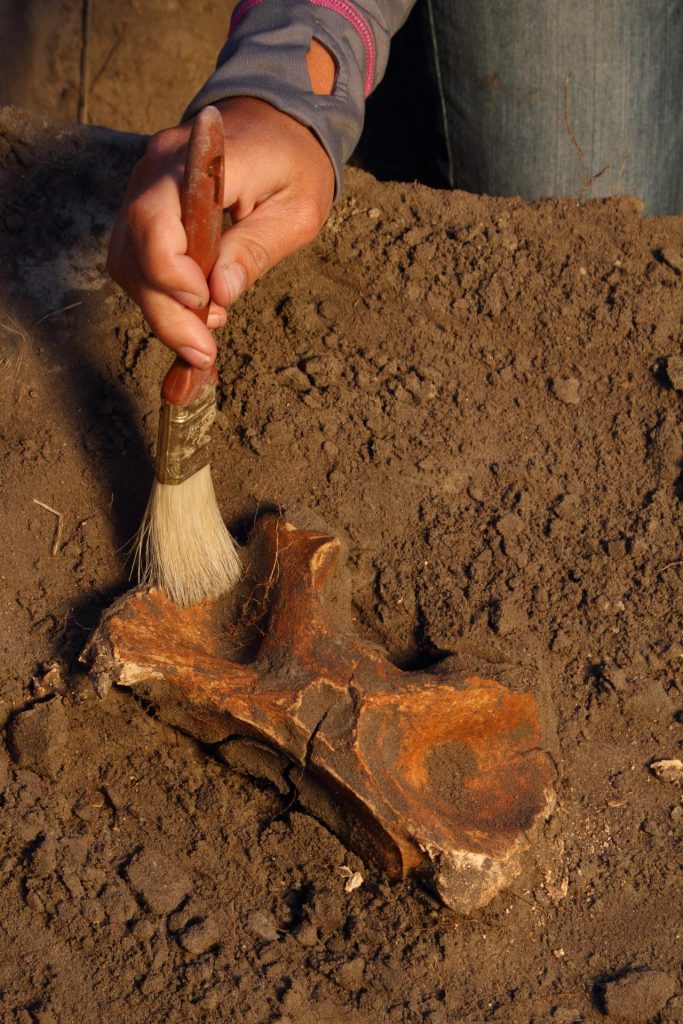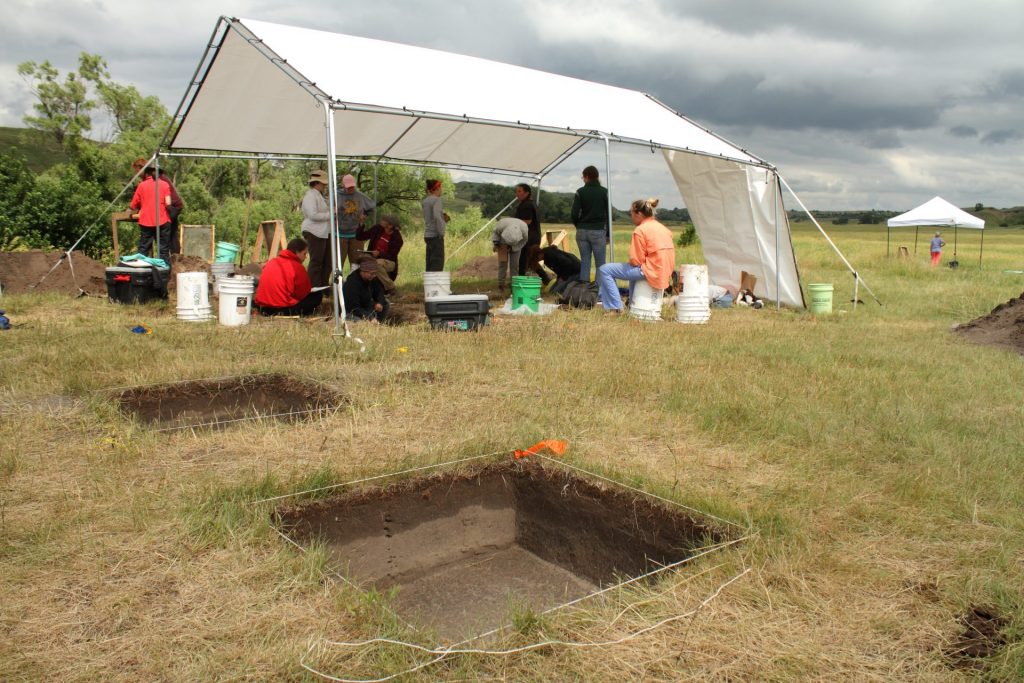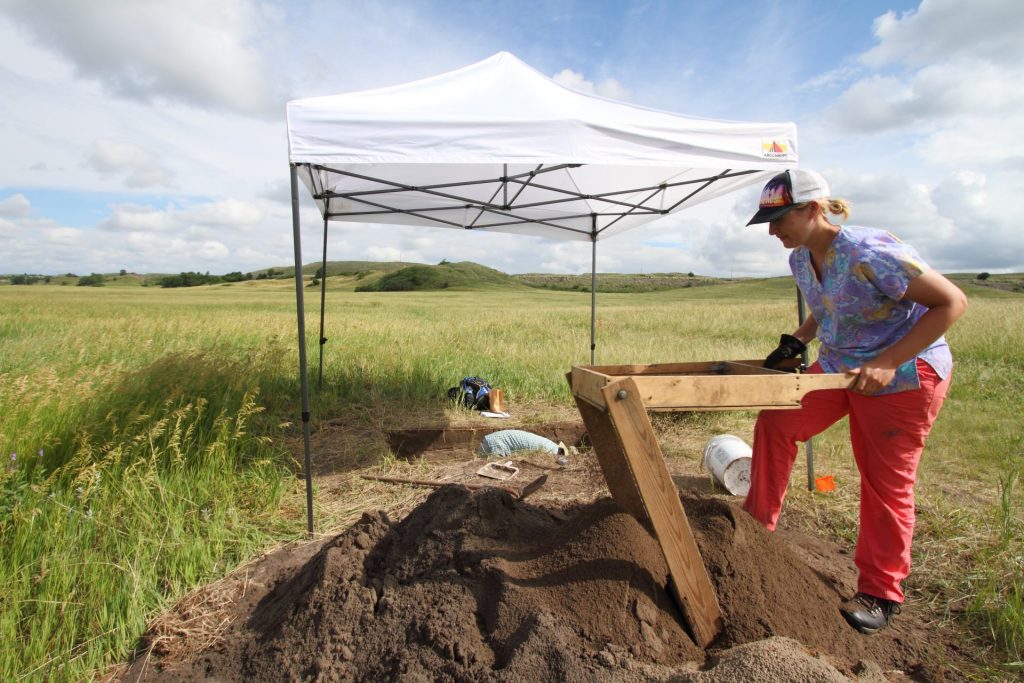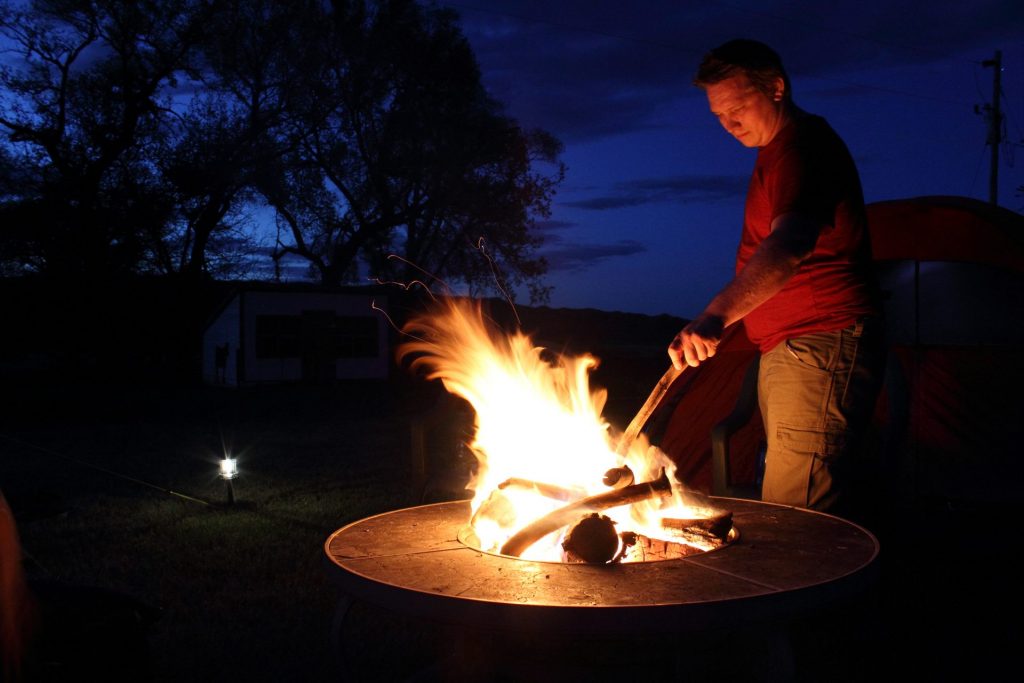Enlarge

Story and photos by Mark Harris
Long ago on grassy hills, a hunter stalks a deer. Wearing skins of the same animal, he loads a thin-shafted spear onto a wooden spear thrower. Rising from cover, he whips the spear into a silent, shallow arch. The stone spear point strikes a mortal wound, but the still-mobile deer bounds away never to be found. Frustrated about the loss of good meat and his prized speckled brown point, the dejected hunter heads home, belly growling.
Two thousand years later, wearing a pink plaid shirt, black sunglasses and a wide-brimmed hat, UNL anthropology student Jodi Enders walks a narrow river’s shoreline in the Nebraska Sandhills. Sweeping her eyes along the base of a cutbank she spots a thin, glossy stone edge jutting from the sand, and the hunter’s spear point is once again held by human hands.
The prehistoric scenario is pure imagination; the hunter could have simply dropped the point, but Jodi Enders surely was the next human to see it.
This was no chance discovery. Enders spotted the artifact after walking 12 days in isolated regions of the Nebraska Sandhills with a dozen other anthropology students on a quest to find human sites lost to history. Led by archaeologists Rob Bozell and Courtney Ziska, and by UNL Professor Phil Geib, this University of Nebraska field school targeted Nebraska’s little-known Snake River, which discreetly rises from underground springs 20 miles south of Gordon, winds under two remote highways and then enters the Merritt Reservoir 60 miles east.

“We are trying to determine what people were doing in the Sandhills throughout human history, who they were and when they were here,” Bozell said. “To understand this one needs data in the form of artifacts. Projectile points, cutting blades, hide scrapers and other tools tell stories. Arrowheads can tell you when, and pottery can be linked with certain tribes.”
On massive ranches like that of the Sasse family, 30 miles southeast of Gordon, Bozell and crew were the very first to conduct systematic archaeological surveys. “We found sites ranging from 1800s ranching all the way back to 10,000 years ago,” he said. The older discoveries place humans here around the time when the Sandhills first became habitable after grasses took root in the once-shifting sands.
Though Nebraska’s Sandhills provided ample game, it was void of crucial tool-making stone. People living here would have coveted the tools they carried; acquiring more lustrous flint meant travelling far. West toward the Rockies was one option, but rich pockets of high quality stone also existed to the east. Ancient people living in what is now the Central Republican Valley, or in Cass and Sarpy counties, lived in virtual hardware stores.
After thousands of years of human inhabitance, the Sandhills are heavily peppered with artifacts, but most will never be found. “In this region most artifacts lie from just under the surface to 30 feet deep,” laments Bozell. “Less than one percent of what’s out there is above ground.” The eyes of a dozen relentless anthropology students better the odds, though. The sea of grass reveals nothing, but ever-present gopher mounds expose the sand, as do cutbanks and cattle trails. Any exposed artifact was likely long buried and then unearthed by animals, people, or erosion.
Ceaselessly scanning the ground, the students trudge over rolling terrain. Conversations are difficult in search lines 20 meters apart, and earbuds are not allowed. Strong winds bring relief from loathed deerflies, but the trade-off is blown sand irritating eyes, ears and noses.

This daily grind catches many students off guard. A few would rather not be here, but they will not graduate as an anthropology major without a field school under their belt. “Those of us who are really obsessed with archaeology don’t mind putting in the energy to make these discoveries,” said UNL junior Reagan Duranski of Lincoln. “I sing songs in my head all day and daydream of what I’ll do when I get back home. I imagine taking the longest shower ever and eating whatever I want.”
Most students here are city-raised and new to outdoor experiences, but becoming an archaeologist means learning to work all day under the sky – what to pack, what to wear, which snakes pose threats, what direction thunderstorms are moving, and orienteering without a cell phone. Pitching a tent was a first for most, or as in the case of one young man, a second. “I practiced setting it up in my garage,” he laughed.
All students are stunned by the region’s endless hills, but particularly wide-eyed was one from New England, astonished by the vastness of privately owned ranches and the absence of human structures and services. Two hours round trip from stores, forgotten personal items loom large. Those who packed bug-bite cream become saviors. Craved foods are hopelessly distant – café lattes are of another life. One bathroom within the rancher’s home is shared by all 12 students, and a communal dinner prepared by the ranch family is devoured at day’s end.

Evenings are for socializing. Lasting friends are made around campfires while sharing adventure stories and diving deep into topics suited only for anthropology fanatics. Blistered feet are cared for. And then, often to the sound of yipping coyotes, they retire into tents hoping it won’t storm. At dawn they rise and repeat. There are more artifacts out there and most have remained undiscovered for a remarkably long time.
“We don’t find many artifacts from the more recent nomadic tribes,” said Bozell. “After the 1700s, Nebraska’s inhabitants quickly adopted European technology, abandoning stone tools and pottery, leaving far fewer artifacts to discover.”
Of those tribes that inhabited the western Sandhills at one time or another, most are familiar to us, such as various Lakota (Sioux) bands, Cheyenne, Comanche, Arapaho, and Pawnee. But less known to the average Nebraskan are the Plains Apaches, who lived in and transitioned through the region over several centuries.

Along the Middle Loup River near what is now Mullen, Nebraska, one mid-1600s Plains Apache village thrived. Originally discovered in 1947 by an advanced archaeological team surveying for a potential reservoir project, most of the village remained unearthed until 71 years later when the student team descended upon it with shovels, trowels, and sifters.
Using ground-penetrating radar and a magnetometer to locate best areas to dig, the team first noticed burned structural remains which were once frameworks for small dome-shaped houses that would have been covered in hides, grass or possibly clay. No one will ever know if the structures burned during occupancy or by prairie fires after the village was abandoned.
In precisely dug rectangular trenches the team located fireplaces and a diverse assortment of stone artifacts. Nearby garbage pits brimmed with bones from bison, deer, antelope and small mammals. Turtles were also on the menu, as their numerous shells revealed. A few pottery sherds helped to identify the Plains Apache tribe, while carbon dating of the village’s organic matter pinned down the era.

Originally from arctic Canada and Alaska, the Plains Apaches began migrating south over 1,000 years ago. Their artifacts have also been located along the Republican River and westward to the foothills of the Rockies, but the Mullen site seems to be one of a handful that was an actual village, likely consisting of extended family bands. “Dozens probably lived in this village on and off for several years or even decades,” Bozell said.
To live in the Nebraska Sandhills 400 years ago meant bringing down bison and other large game with wood and stone tools. Bows and arrows or spears with spear throwers were top technologies. Butchering and hide cleaning required stone blades and scrapers, while bone awls and stone drills were used to make clothing.
Travel would have been grueling in an era without horses, but the Plains Apaches would have journeyed far enough to encounter surrounding groups and to trade goods, which was possibly how they acquired one unique little arrowhead discovered within the village. Made of shiny black obsidian, it came from the Rockies or the Southwest.

Although white people were establishing their foothold on the same landmass during this village’s era, European influence was still a world away. The steady trickle of fur traders would be 100 years to come – the systematic eradication of Plains Indians another hundred more. But the Plains Apaches left Nebraska before white men appeared, the last departing in the early 1700s. Likely pressured by the Comanche from the west or the Pawnee from the east, they eventually formed lasting alliances with the Kiowa to the south.
Stark contrasts exist between these hardy peoples who lived in the Sandhills hundreds or thousands of years ago and the budding archaeologists examining what they left behind. But to learn about these long absent cultures is to respect their rugged way of life and to wonder, as did Jodi Enders after discovering the spear point. “How long were they out hunting that day?” she asks. “How far did they walk? What was their camp like? What were they like?”
Artifacts yet to be discovered may cause theories to shift, ever correcting as the sciences do. Beneath our feet they lay – 30 feet or half-an-inch below fields and roadways, beneath buildings and backyards. You likely passed over a stone artifact today. What of our things will survive thousands of years, and what of that will be worth finding? And those distant-future people studying the 21st century … what will they think of us? ■
Mark Harris is the associate director of the University of Nebraska State Museum.
The post Finding History in the Sandhills appeared first on Nebraskaland Magazine.
















